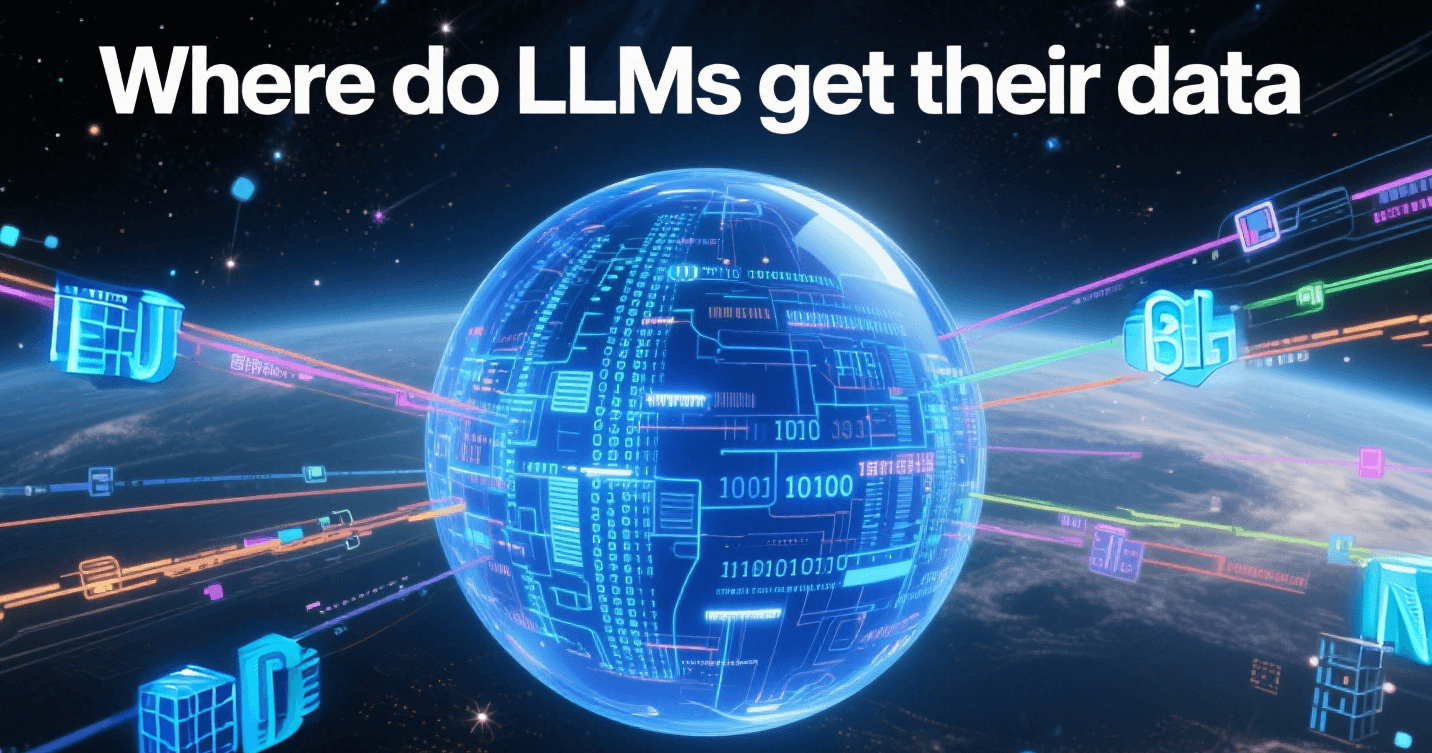Large Language Models (LLMs) like GPT-4, LLaMA, and PaLM have revolutionized AI with their ability to generate human-like text, answer questions, and even code. But behind their impressive capabilities lies a foundational question: Where do these models get their data? The answer matters because the quality, diversity, and origin of LLM training data directly shape a model’s accuracy, bias, and ability to perform tasks like data inference—the process of deriving insights or generating outputs from input data.
What Are LLMs?
Large Language Models (LLMs) are advanced artificial intelligence systems trained on massive amounts of text data to understand, generate, and manipulate human language. They belong to the broader category of machine learning, specifically deep learning, leveraging large-scale neural networks with billions (or even trillions) of parameters.
At their core, LLMs learn patterns, grammar, semantics, and contextual relationships from text. By analyzing vast datasets—including books, websites, articles, and more—they identify how words, phrases, and ideas connect, enabling them to predict the most likely sequence of text in a given context.
The Primary Sources of LLM Training Data
LLMs are trained on massive datasets—often hundreds of billions to trillions of tokens (words or subwords). These datasets draw from a mix of public, licensed, and sometimes proprietary sources, each contributing unique value to the model’s knowledge.
1. Publicly Available Text Corpora
The largest portion of LLM training data comes from publicly accessible text, aggregated into massive datasets.
- Common Crawl: A nonprofit initiative that crawls the web and archives billions of web pages annually. It includes blogs, forums, news sites, and more, making it a staple for models like GPT-3.
- Wikipedia: A free, crowdsourced encyclopedia with over 60 million articles in 300+ languages. Its structured, verified content helps LLMs learn factual information.
- Books and Literary Works: Datasets like BookCorpus (containing over 100,000 books) and Project Gutenberg (public-domain books) teach LLMs narrative structure, formal language, and complex ideas.
- Academic Papers: Repositories like arXiv and PubMed provide scientific texts, enabling LLMs to understand technical jargon and research concepts.
2. Social Media and User-Generated Content
Platforms like Reddit, Twitter (X), and forums (e.g., Stack Overflow) contribute informal, conversational data. This helps LLMs learn slang, dialogue patterns, and real-time cultural references. For example, Reddit’s diverse subreddits offer niche knowledge—from cooking tips to quantum physics discussions—enriching the model’s contextual understanding.
3. Licensed Datasets
To avoid copyright issues or access high-quality data, some LLM developers license content from publishers. This includes:
- News Articles: Licensed from outlets like The New York Times or Reuters for up-to-date information.
- Books: Partnerships with publishers (e.g., Penguin Random House) for access to copyrighted books.
- Specialized Databases: Medical records (de-identified), legal documents, or financial reports for domain-specific LLMs (e.g., healthcare chatbots).
4. Synthetic and Augmented Data
In cases where real-world data is scarce or biased, developers create synthetic data using existing models. For example, an LLM might generate fictional dialogues to balance underrepresented languages. Data augmentation—rephrasing sentences, adding synonyms—also expands training sets without new raw data.
The LLM Data Pipeline
1. Data Collection and Crawling
Tools like Scrapy or custom crawlers extract public data, while APIs access licensed content. Platforms like Common Crawl simplify this by providing pre-crawled web archives, reducing redundancy for developers.
2. Cleaning and Filtering
- Removing Noise: Duplicates, spam, or low-quality text (e.g., gibberish) are deleted.
- Filtering Harmful Content: Hate speech, misinformation, or explicit material is removed to align with ethical guidelines.
- Standardization: Text is converted to lowercase, punctuation is normalized, and non-text elements (e.g., images) are stripped.
3. Tokenization
Raw text is split into smaller units (tokens)—words, subwords, or characters—so the model can process it numerically. For example, “unhappiness” might split into “un-”, “happiness” to handle rare words efficiently.
4. Alignment with Objectives
Data is labeled or categorized to match the model’s purpose. A customer service LLM, for instance, prioritizes conversational data over scientific papers.
Data Inference: How LLMs Use Their Training Data
Data inference is the core of an LLM’s functionality. It refers to the model’s ability to use patterns learned from training data to generate new, contextually relevant outputs. Here’s how it works:
- Pattern Recognition: During training, the model identifies relationships between words (e.g., “sun” often pairs with “shine”) and concepts (e.g., “Paris” → “France”).
- Contextual Prediction: When given an input (e.g., “The capital of Japan is”), the model infers the most likely continuation (“Tokyo”) by referencing its training data.
- Generalization: LLMs apply learned patterns to new, unseen data. For example, a model trained on books can still answer questions about a novel it never read, thanks to inferred similarities.
The quality of LLM training data directly affects inference accuracy. A model trained on biased data (e.g., gender-stereotyped texts) may produce biased inferences, while diverse, high-quality data leads to more robust outputs.
LLMs in Production: Databricks Model Serving and Data Management
Once trained, LLMs need efficient deployment to deliver data inference at scale. Tools like Databricks Model Serving streamline this by managing data pipelines and optimizing inference performance.
Databricks Model Serving is a cloud-based platform that deploys, scales, and monitors ML models—including LLMs. It integrates with Databricks’ data lakehouse architecture, unifying data storage, processing, and model serving.
How It Supports LLM Data Workflows
- Unified Data Access: Connects directly to LLM data (training, validation, or real-time inputs) stored in lakes or warehouses, reducing data movement delays.
- Optimized Inference: Auto-scales resources to handle traffic spikes, ensuring fast data inference even for large inputs (e.g., 10,000-word documents).
- Monitoring and Feedback Loops: Tracks inference accuracy and collects user interactions to retrain models with new data, keeping outputs relevant.
For example, a healthcare company using Databricks can deploy an LLM to analyze patient records. The platform ensures the model accesses clean, up-to-date medical data, enabling accurate inferences (e.g., suggesting diagnoses based on symptoms).
Challenges in LLM Data: Ethics, Bias, and Copyright
LLM data sources face critical challenges that impact trust and reliability:
1. Copyright and Legal Risks
Scraping copyrighted content (e.g., books, news) can lead to lawsuits. Developers increasingly rely on licensed data or “fair use” principles, but ambiguity remains.
2. Bias and Representation
Training data often reflects societal biases (e.g., underrepresenting women in STEM texts). This leads to skewed inferences—for example, an LLM might assume a “doctor” is male.
3. Privacy Concerns
User-generated data (e.g., social media posts) may contain personal information. Anonymization helps, but re-identification (matching data to individuals) remains a risk.
4. Data Freshness
LLMs trained on outdated data (e.g., pre-2020 texts) struggle with recent events (e.g., “What is ChatGPT?”). Tools like Databricks Model Serving address this by integrating real-time data feeds for continuous retraining.
Future Trends: Improving LLM Data and Inference
- Smaller, High-Quality Datasets: Developers are moving from “bigger is better” to focused datasets, reducing compute costs while boosting inference accuracy.
- Ethical Data Alliances: Partnerships between tech firms and publishers (e.g., Google’s News Showcase) aim to legalize data access.
- Explainable Data Inference: Tools to trace an LLM’s outputs back to specific training data, increasing transparency.
LLMs draw their power from diverse data sources—public texts, licensed content, and synthetic data—processed through rigorous pipelines to enable accurate data inference. The quality of LLM training data directly shapes a model’s ability to generate logical, unbiased outputs. Tools like WhaleFlux, which optimizes multi-GPU cluster utilization to cut cloud costs and enhance LLM deployment speed and stability, support the transition from training to production. As the field evolves, addressing ethical and legal challenges in data sourcing will be key to building trustworthy, impactful LLMs.

